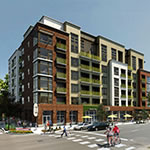One of Sacramento’s prime midtown parcels is getting a LEED Platinum mixed-use building, thanks to the efforts of D&S Development. The property, which is directly across from Fremont Park and within a few blocks of the state capitol, had been on D&S Development’s radar for nearly a decade.
When financing became a recurring obstacle for other developers, D&S Development was tapped by the Capital Area Development Authority (CADA), a state housing authority that historically has played a significant role as a public partner on many key sites around the state capitol. In response, the developer created 16 Powerhouse Investors and outlined a plan for a project that would raise the bar for sustainable housing.
When finished in fall of this year, the ground floor of the six-story, wood-frame building will feature almost 8,000 square feet of retail space, which is already leased by three different companies, including Insight Coffee Roasters, Orchid Thai, and Magpie Cafe. Above the retail space will be 50 units of high-end condominium space with an average unit size of 1,050 square feet, which is significantly larger than typical projects in the area. Rounding out the project will be 49 parking spaces accessible via an innovative lift system used in major cities such as Tokyo and New York.

To spur resident interactions, the courtyard provides gardens, bike storage, and a dog-washing station. Below the building is a stacked parking garage, a technique used in dense cities such as New York City and Tokyo.
16 Powerhouse will be a unique addition to the Sacramento landscape, in part because of its more traditional offerings. “Most of the apartments built over the past 10 years, even those we’ve done, have featured smaller, loft-style floor plans, which cater to a certain demographic,” says Bay Miry of D&S. “We wanted to do a project that would cater to residents with more spending power, such as young professional couples and empty nesters who live in the suburbs and want a place in the city. Those residents often want a larger and more traditional, divided floor plan.”
Sustainability is also increasingly appealing to that demographic, which led D&S to pursue LEED Platinum certification for the project. “In recent years, we’ve tried to focus more on sustainable development, and we thought that would be an effective way to do something unique in the eyes of the residents,” Miry says. “Then as we got into the project, we realized there were a lot of ways we could justify sustainable features that you don’t see in most apartment buildings, and you don’t see at all in projects that are market rate and higher end. LEED certification tends to be concentrated in projects that receive building subsidies, such as student housing and low-income projects. Our goal is to build the most sustainable market-rate apartment building in the region, if not the country.”
One of the most notable features of the project is the solar array that connects to the electrical meter and provides electricity for all common areas, including interior spaces and a lighted courtyard. The project also will have solar hot water, which will allow residents to reduce electrical costs associated with water heating. Miry says this system is 75 percent more efficient than a typical water heater.

ELSEWHERE IN SACRAMENTO
A survey of D&S Development’s past projects
Maydestone Apartments
Located on the border of midtown and downtown Sacramento across from the convention center and Memorial Auditorium, the project is a registered historic building, renovated in 2011, and provides 32 rental apartments.
Sterling Hotel
A historic Victorian mansion, which was built in 1894 by successful department-store entrepreneurs known as the Hales family, offers a 17-room hotel, a restaurant, and ballroom.
14th and R (pictured)
Located in the R Street Corridor of midtown Sacramento, the historic structure was converted from a bread factory into a mixed-use project in 2009. The Sacramento Business Journal named it “Best Project of the Year.”
In addition to sophisticated systems that provide ultra-efficiency—a passive airflow system, high R-value insulation, LED lighting, and variable-refrigerant-flow HVAC technology—each unit comes with an energy-monitoring system that will tell owners how much energy they’re using in specific categories. Residents will be able to check their energy use with a smartphone app. “We worked closely with our contractor, TriCorp Hearn, and the Sacramento Municipal Utility District, whose ‘Saving by Design’ program really helped us find areas to achieve energy savings and rebates,” Miry says. D&S used on-site natural materials for the design, choosing to repurpose three 100-foot tall redwood trees into benches and furniture for the interior courtyard and ground-floor streetscape.
Miry is hoping that 16 Powerhouse project will inspire a trend in the Sacramento real estate market, where he sees a great need for high-quality housing in the urban core. “It really raises the bar for market-rate, mixed-use development both in terms of quality and sustainability,” he says. “There was a time when the cost of sustainability was thought to be too much, and this project illustrates that it isn’t. We’re hoping it will be educational and show people you can do sustainable mixed-use development and still have a successful, quality project.”

